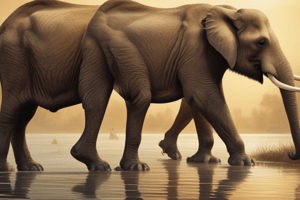Podcast
Questions and Answers
¿Cuál es el principal objetivo de los programas de cría en cautiverio?
¿Cuál es el principal objetivo de los programas de cría en cautiverio?
- Aumentar las poblaciones de especies en peligro de extinción en cautiverio antes de liberarlas en la naturaleza (correct)
- Evitar que las especies en peligro de extinción se extingan por completo
- Proporcionar animales para los zoos y parques temáticos
- Mantener la diversidad genética de las especies en peligro de extinción
¿Cuál de los siguientes factores NO contribuye al declive de la biodiversidad?
¿Cuál de los siguientes factores NO contribuye al declive de la biodiversidad?
- Políticas gubernamentales de protección ambiental (correct)
- Sobreexplotación
- Especies invasoras
- Deforestación
¿Cuál de los siguientes no es un servicio ecosistémico crucial proporcionado por los ecosistemas?
¿Cuál de los siguientes no es un servicio ecosistémico crucial proporcionado por los ecosistemas?
- Producción de energía eléctrica (correct)
- Secuestro de carbono
- Formación de suelo
- Filtración de agua
¿Cuál de las siguientes estrategias de conservación se enfoca en permitir que los animales se muevan entre hábitats fragmentados?
¿Cuál de las siguientes estrategias de conservación se enfoca en permitir que los animales se muevan entre hábitats fragmentados?
¿Cuál de los siguientes problemas para la vida silvestre NO es causado por la pérdida de hábitat?
¿Cuál de los siguientes problemas para la vida silvestre NO es causado por la pérdida de hábitat?
¿Qué aspecto del comportamiento animal puede ayudar a determinar el tamaño de las poblaciones de forma efectiva?
¿Qué aspecto del comportamiento animal puede ayudar a determinar el tamaño de las poblaciones de forma efectiva?
¿Qué proceso es crucial para mantener el equilibrio del medio ambiente según el texto?
¿Qué proceso es crucial para mantener el equilibrio del medio ambiente según el texto?
¿Cuál es uno de los principales objetivos de las iniciativas de conservación mencionadas en el texto?
¿Cuál es uno de los principales objetivos de las iniciativas de conservación mencionadas en el texto?
¿Cuál de los siguientes factores NO se menciona como una amenaza para la vida silvestre en el texto?
¿Cuál de los siguientes factores NO se menciona como una amenaza para la vida silvestre en el texto?
¿Qué proceso ayuda a informar los esfuerzos de conservación para especies que migran grandes distancias?
¿Qué proceso ayuda a informar los esfuerzos de conservación para especies que migran grandes distancias?
Flashcards are hidden until you start studying
Study Notes
Wildlife: Animal Behavior, Conservation, Habitat Loss, Biodiversity, Ecosystems
Introduction
Wildlife refers to all non-domesticated animals and plants found naturally within their respective ecosystems. These organisms play a crucial role in maintaining the balance of their environment through various interactions, including predator-prey relationships, pollination, seed dispersal, nutrient cycling, and other essential processes that support life. However, human activities have significantly impacted many aspects of wildlife, leading to concerns over animal behavior, conservation efforts, habitat loss, biodiversity, and ecosystem health. This article aims to explore these issues in detail.
Animal Behavior
Animal behavior is the study of how animals interact with each other and their environments. It includes various aspects like communication, social structure, mating patterns, migration, feeding habits, and more. Understanding animal behavior helps us appreciate their complex lives and develop strategies to conserve them. For example, monitoring mating rituals can help determine population sizes, while understanding migration patterns can inform conservation efforts for species that migrate over large distances.
Conservation Efforts
Conservation initiatives aim to protect endangered species and their habitats from threats like habitat loss, climate change, pollution, and human activities. Some successful conservation strategies include:
- Protected Areas: Designating specific regions as protected areas provides legal protection for wildlife, either by excluding human activities or regulating them. Examples include national parks, nature reserves, and wildlife sanctuaries.
- Captive Breeding Programs: Many organizations worldwide run breeding programs to help increase populations of endangered species in captivity before releasing them back into the wild.
- Wildlife Corridors: These are passages that allow animals to travel between fragmented habitats, promoting genetic diversity and reducing isolation within populations.
Habitat Loss
Habitat loss occurs when natural ecosystems are altered, destroyed, or degraded due to human activities such as agriculture, urbanization, mining, logging, and infrastructure development. This often leads to a decline in biodiversity and can cause numerous problems for wildlife, including:
- Food shortages
- Increased competition for resources
- Exposure to predators
- Stress from noise pollution
To mitigate habitat loss, it's essential to promote sustainable land use practices, support reforestation initiatives, and implement policies that protect vital ecosystems.
Biodiversity
Biodiversity refers to the variety of life on Earth, including all plants, animals, fungi, and microorganisms, as well as the genes they carry. High levels of biodiversity contribute significantly to ecosystem health and stability. However, human activities have led to rapid declines in many species and their habitats, threatening the balance of our planet. Some factors contributing to this decline include deforestation, overexploitation, invasive species, climate change, and pollution. Efforts to preserve biodiversity involve protected area creation, habitat restoration, biotechnology research, and public awareness campaigns.
Ecosystems
Ecosystems are complex networks of interconnected organisms and physical factors that function together to create unique environments supporting life. They provide critical services like nutrient cycling, water filtration, soil formation, and carbon sequestration. Human activities have disrupted these delicate balances, leading to various environmental issues. Protecting and restoring ecosystems requires understanding their underlying processes, implementing sustainable management practices, and minimizing anthropogenic impacts.
In conclusion, understanding animal behavior, conservation, habitat loss, biodiversity, and ecosystems is crucial for preserving wildlife and maintaining our planet's ecological health. By adopting responsible behaviors and supporting scientific research, we can make significant progress towards safeguarding the future of Earth's incredible array of organisms.
Studying That Suits You
Use AI to generate personalized quizzes and flashcards to suit your learning preferences.




